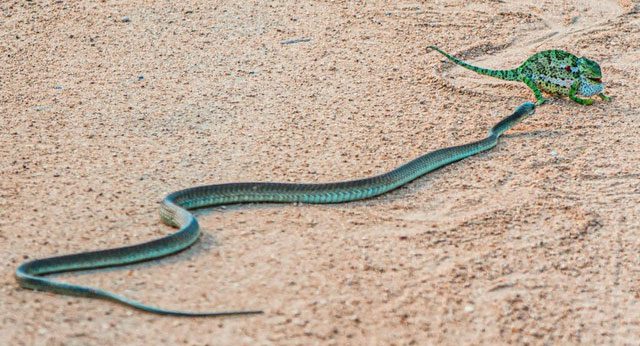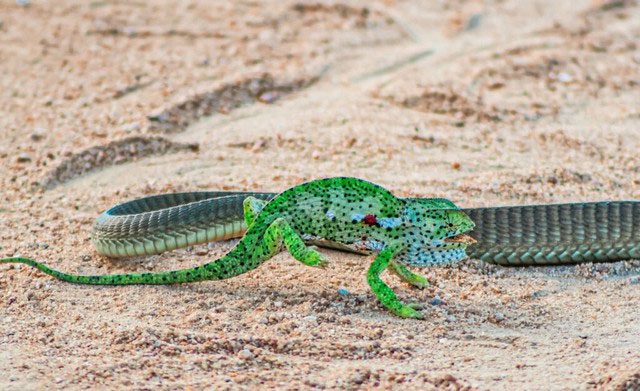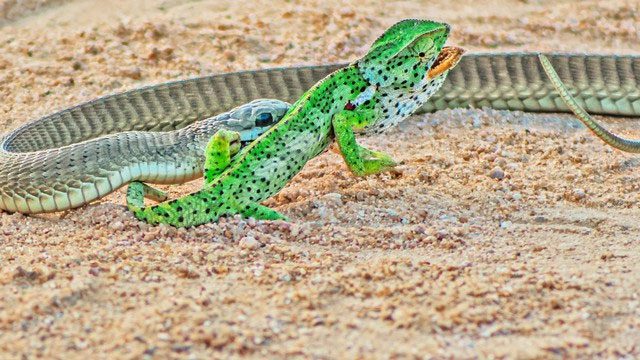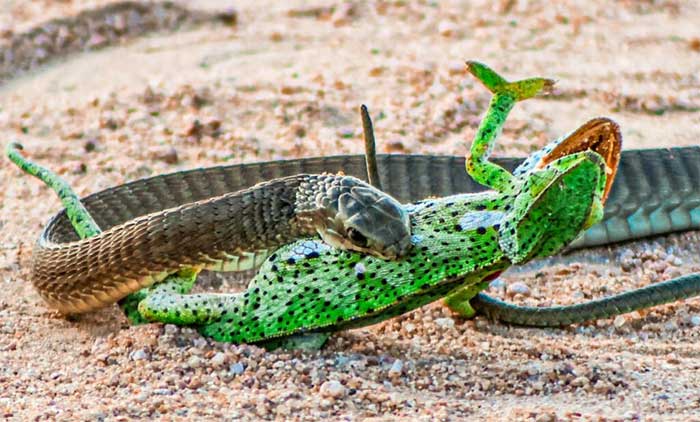The Boomslang (Dispholidus typus) is a highly venomous snake that can cause severe symptoms in humans if bitten.
Chante Lee Cloete and her husband had a memorable experience during their trip to Kruger National Park, South Africa, when they witnessed two members of the reptile class battling each other.
That day, the Cloete family chose to take the S21 sandy road in search of predatory animals. The cool breeze and the lush trees along the route made everything perfect for the tourists. Suddenly, Cloete’s husband stopped the car and began asking questions about a strange creature on the road.

The Boomslang and its opponent.
Looking in the direction he pointed, everyone saw that it was not a lion or a leopard, but a Boomslang. This highly venomous snake typically measures between 100-160 cm in length, with some individuals reaching up to 183 cm.
Boomslangs are found in various locations across the grasslands, dense forests, and lowland woodlands throughout sub-Saharan Africa, including Swaziland, Namibia, Zimbabwe, and Mozambique. They spend most of their time moving between branches to hunt, rest, and sleep.
This snake has large eyes, an egg-shaped head, and males are bright green with a mix of blue and black on their heads, while females can be brown. They possess fangs that are 3-5 mm long and nearly 0.5 mm in diameter. Notably, this species has excellent vision, comparable to that of a normal human.

A bite from a Boomslang can cause the victim to bleed to death.
The Boomslang possesses the strongest venom in the rear-fanged snake group. Today, it is ranked among the most venomous snakes in Africa. When injected into a victim’s body, the venom can attack the circulatory system and prevent blood clotting. Victims may bleed externally and internally until death occurs. Due to its slow-acting effect on humans, the venom is used more as an offensive weapon against smaller animals rather than as a defense mechanism against larger ones.
Notably, the venom of the Boomslang not only causes external symptoms such as headaches, nausea, drowsiness, and anxiety, but it also leads to coagulation disorders. This is because the snake’s venom contains hemotoxins, chemicals that can destroy red blood cells, disrupt blood clotting, reduce organ function, and lead to tissue degeneration.
Additionally, when threatened by predators, they can expand their necks and open their mouths to appear more intimidating. They also secrete a foul-smelling substance to deter enemies.


The prey stands little chance against the Boomslang.
The Boomslang’s opponent is a chameleon, primarily found in Africa and Madagascar. Approximately 50% of chameleons in the world are endemic to Madagascar, with only 66 species identified so far. Perhaps the chameleon is the most unique among all lizard species, perfectly “designed” for arboreal living.
Chameleons are excellent swimmers, able to inflate their bodies with air. Their pupils can move independently, allowing them to look in two directions simultaneously without moving their heads. This ability is particularly useful for an animal that must camouflage itself to avoid predators. Chameleons can remain completely motionless to monitor danger and prey from all angles. Once they locate their target, usually insects, chameleons rapidly extend their long, sticky tongues to catch the fast-moving prey.
However, despite their strength and agility, the snake ultimately managed to kill its opponent in front of everyone.


















































